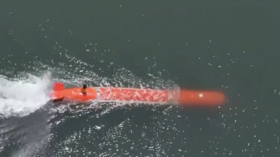Life on Mars: Walk on Red Planet simulated in Austrian glacier at 2,700 meters (VIDEO)

This Austrian glacier has similar conditions to those on Mars. Watch the video and see how European scientists simulate getting about on the Red Planet.
The video project was filmed on a glacier at an altitude of 2,700 meters. Around 100 scientists and crew from 19 countries participated.
In the video, the German meteorologist Carmen Koehler and Spanish space technology expert Inigo Munoz Elorza are wearing 50-kg space suits, as they endeavor to cope with the icy environment - similar to that on Mars.
"Bending down and getting up again is difficult," Koehler said, as quoted by the Dalje.com website.
#VIRAL: Alien woman with breasts' watching Mars rover spotted by UFO lovers http://t.co/oKSiAFkNi2pic.twitter.com/khkjks27Vk
— RT (@RT_com) August 6, 2015A manned Mars trip is set to happen in 20 to 30 years, the Austrian Space Forum estimates, and will take about 1,000 days, with half of that time spent on the Red Planet.
There are many technical challenges regarding the trip to Mars. For one thing, the astronauts will experience 20-minute delays when communicating with mission control. This is due to the 200-million-kilometer distance between Earth and Mars.
"It's like a slow online chat," one of the leading space scientists at the Austrian Forum, Gernot Groemer, said.
The experiments on the glacier include steam showers, psychological research to find out how humans behave in extreme situations, as well as ideas on how to tackle issues such toothaches at the final frontier.
For the latter, there is a potential solution: a 3D printer to produce dental prosthetics.













